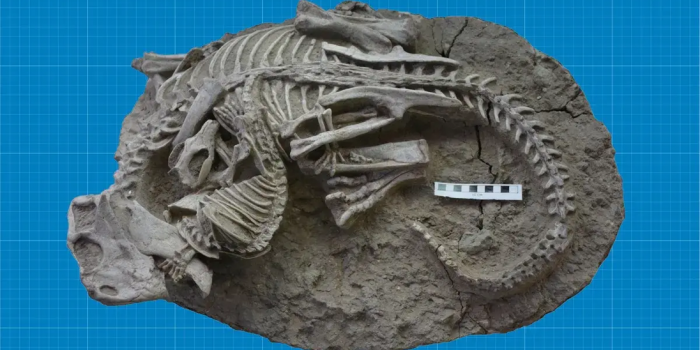In a mesmerizing snapshot from the depths of history, a fearless mammal the size of a house cat challenges a dinosaur three times its size in an epic clash.
Preserved in a fossil unearthed in northeastern China, the entwined remains of Repenomamus robustus, a badgerlike creature, and a Psittacosaurus, a plant-eating dinosaur, defy the conventional belief that early mammals were merely bystanders in the shadow of dinosaurs.
Paleobiologist Jordan Mallon, a research scientist at the Canadian Museum of Nature and coauthor of the Scientific Reports study, explains this extraordinary fossil’s significance. Until now, the general belief was that larger dinosaurs exclusively preyed upon smaller mammals, leaving the mammals at a distinct disadvantage. However, this fossilized encounter upends this notion, suggesting that mammalian predators of the time possessed the strength and tenacity to bring down much larger prey when driven by hunger or desperation.

What makes this discovery truly captivating is the portrayal of Repenomamus robustus in the act of attacking the nearly fully grown Psittacosaurus. Fossils capturing such dynamic interactions between species are exceedingly rare and offer invaluable insights into the predatory behavior of extinct creatures. It is comparable to the iconic “dueling dinosaurs” fossil, where a Triceratops and a Tyrannosaurus rex are locked in an eternal battle.
The Psittacosaurus, a small beaked dinosaur that was abundant in the region during that era, found itself in the clutches of the Repenomamus robustus. The mammal, roughly the size of a house cat, rose to the challenge of confronting a much larger opponent. Both predator and prey had reached maturity when the fateful encounter occurred, intensifying the significance of this fossil’s preservation.

The excitement surrounding this fossil is palpable as Mallon describes his elation at the opportunity to study such a remarkable specimen. Discovered in China’s Liaoning province at the Lujiatun fossil beds, this near-complete fossil provides an exceptional window into a pivotal moment of ancient predation. The level of preservation is awe-inspiring, making it a once-in-a-lifetime find that captivates the imagination.
Through careful analysis, Mallon and his colleagues have determined that the mammal was an aggressor rather than a scavenger. The absence of scavenging bite marks and the intertwined position of the two creatures strongly indicate an act of predation rather than a fortuitous encounter with a deceased dinosaur. This predatory struggle ended abruptly, with both creatures perishing together, entombed by a mudslide triggered by a volcanic eruption.

While the ultimate outcome of this ancient clash remains unknown, Mallon suggests that victory for the mammal was entirely possible. Drawing parallels to modern-day examples of smaller carnivores triumphing over much larger prey, such as weasels overpowering hares or wolverines subduing caribou, the fossilized encounter provides a glimpse into the extraordinary capabilities of ancient mammals.
Regardless of the precise outcome, the fossilized remains witness a titanic struggle between two prehistoric creatures, forever united in a shared destiny. This awe-inspiring discovery challenges preconceived notions about the dynamics between early mammals and dinosaurs, offering a tantalizing glimpse into the complex and fierce ecological interactions that shaped our planet’s history.


